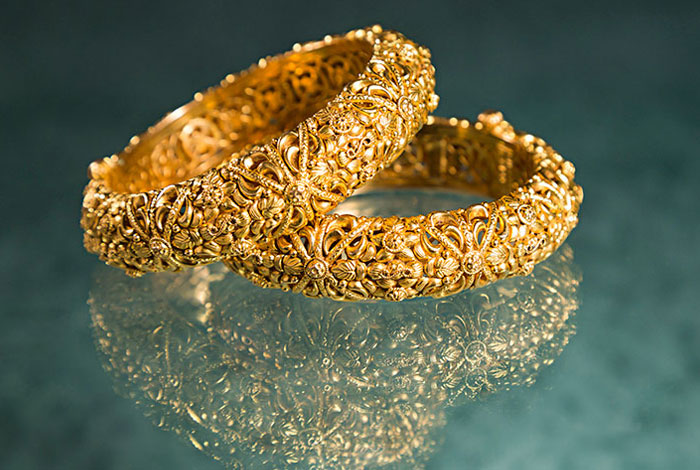
Gold:
When the term “gold” is used alone, it refers to all gold or 24-karat gold (24K). Gold is typically combined with other metals to improve its hardness and durability since it is soft.
The karat quality designation indicates the percentage of gold that has been combined with other metals. The most frequent markings for gold jewellery are 18K or 750 (representing 75 percent gold), 14K or 585 (representing 58 percent gold), and 10K (representing 10 percent gold) (42 percent gold). The lowest level of gold permitted under US law is ten karat gold.
Higher-karat gold jewellery is yellower in colour and slightly softer than lower-karat gold jewellery, which may contain copper, silver, zinc, or other metals. Consumers who are allergic to particular metals or have a high acid content in their body should be cautious about the alloys. When acid reacts with your jewellery, it turns it black and makes it seem low-quality.
Gold jewellery comes in a variety of styles and patterns. Designer jewellery may cost more than generic gold jewellery due to its innovative design and production, but having the designer’s name embossed inside improves the worth of the item.
Follow these suggestions to ensure you get the most value for your money when purchasing gold jewellery:
- Make certain that the item is properly stamped with the carat weight and maker.
- Take note of if the item is prone to damage in the future.
- Make sure the item’s carat weight is mentioned on the sales receipt.
Silver:
The terms silver or sterling silver refer to a product that contains 92.5 percent silver and is stamped with the 925 mark. Silver, despite its lustrous appearance, tarnishes when exposed to the environment, turning dark or black. Tarnish may be removed with a number of solutions available on the market.
Keep these tips in mind when buying sterling silver jewelry:
- Check for the words “925” or “sterling silver” on the item.
- Keep in mind that “nickel silver” and “German silver” are not the same as sterling silver since they do not contain any silver.
- On the sales receipt, make sure the words “sterling silver” are written.
Know Your Jeweler:
Consult with family, friends, and people of the community and business who are familiar with the jewellery store’s reputation. Check the BBB for the store’s Reliability Rating. Inquire about its salespeople’s gemological and appraising training. Find out whether the jeweller is a member of any trade groups and what the membership criteria are.
Knowing more about the business will help you ensure that your jewellery purchase is a success, whether you’re buying it for someone special or as a present for yourself. Knowing you made the finest possible purchase will add to the enjoyment of your jewellery.
Jewelry Manufacturing Techniques:
The manner a piece of jewellery is made has a significant impact on its appearance and longevity.
Here are a few pointers to consider:
- The more prongs a stone has, the better it will stay in place.
- Make sure there’s enough area beneath the gemstone for cleaning.
- Clasps should be simple to open and shut while not being excessively thin or fragile.
- Bracelets and chains constructed of hollow metal can be destroyed over time.